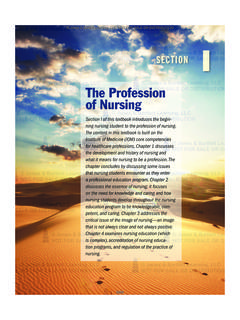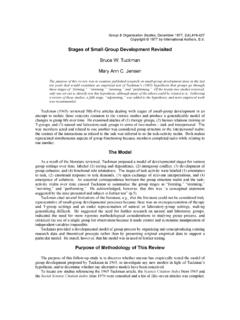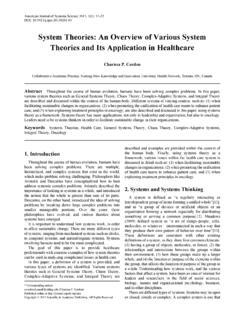Transcription of Applying Middle-Range Concepts and Theories to the Care …
1 Chapter 7 Applying Middle-Range Concepts and Theories to the Care of Vulnerable PopulationsNicole MarenoObjectivesAt the end of this chapter, the reader will be able to1. Describe how Middle-Range Theories in nursing apply to vulnerable Apply at least one theory to a specific population of interest to the Provide at least one research example that uses a Middle-Range disciplinary focus of the nursing profession is to improve the quality of life and health of individuals, families, communities, and society (McCurry, Hunter Revell, & Roy, 2010). Contemporary nursing care is heavily influenced by knowledge development that is happening within a dynamic, evolving social and environmental healthcare con-text (McCurry et al., 2010). Risjord (2010) argued that nursing knowledge development, which he termed the nursing standpoint starts from nurses lives (p. 74), or that the problems and solutions in nursing are identified within nurses daily practice.
2 Problem identification leads to the development, refinement, and dissemination of knowledge, with theory providing the foundation (Risjord, 2010). Risjord posits that appropriate 117 11710/03/15 11:09 amtheories for the nursing profession address nursing problems, whether they are proposed by nurses, or borrowed from other Theories are useful in addressing the problems of nursing , espe-cially among vulnerable populations. Although Middle-Range Theories address specific phenomena within nursing practice, the Theories are broad enough to be applied to a variety of patient populations, and across many practice settings. Middle-Range Concepts and Theories selected for this chapter were adapted from content in a graduate-level fam-ily nurse practitioner course on healthcare theory. In the course, family nurse practitioner students applied Middle-Range Concepts and Theories to practice. Either the concept or an associated theory are discussed and applied to the care of the vulnerable.
3 Concepts from this chapter could be used in doctoral courses for concept analysis and explored in the context of this chapter, eight Middle-Range Concepts or Theories will be discussed. Individual-level Middle-Range Theories , social Middle-Range Theories , and Middle-Range Theories that integrate multiple perspectives will be presented. Definitions of the Concepts comprising each Middle-Range theory will be provided. The Middle-Range concept or theory will be applied to the care of vulnerable populations using a specific example from the literature. Practical application of each Middle-Range concept or theory in the care of vulnerable populations will be Middle-Range THEORIESIn proposing solutions to problems of vulnerability, it is essential to begin by understand-ing individual-level factors. Once the Concepts are understood from an individual level, the influence of families, communities, and populations can be examined.
4 The individual-level Middle-Range Concepts or Theories of self-efficacy, adherence, and change will be has been defined as a system of self-monitoring where an individual judges his or her capability to carry out a behavior or course of action (Bandura & Perloff, 1967; Bandura, 1977). Cognitive processing, in the form of reflective thought, helps individuals to set standards for their behavior and then generate skills necessary to accomplish behavioral goals. Bandura and Perloff (1967) noted that individuals generate self-prescribed rewarding or punishing consequences that they apply depending on how their behavior compares to a self-selected external evaluation criterion. An assumption of self-efficacy theory is that individuals have the cognitive ability to exercise behavioral control and create evaluation criteria to judge their Chapter 7 Applying Middle-Range Concepts and 11810/03/15 11:09 amIn social cognitive theory, Bandura (1986) asserted that self-efficacy was an important mediator within the triad of reciprocity among behavior, cognition, and other personal/environmental influences.
5 Bandura (1977) proposed two components of self-efficacy: self-efficacy expectations and outcome expectations. Bandura defined self-efficacy expec-tations as an individual s belief that he or she can successfully carry out a behavior to produce an anticipated outcome. Bandura defined outcome expectations as a person s estimation that a particular behavior will lead to a particular outcome. An individual may believe that a particular behavior leads to a certain outcome (outcome expectations), but may or may not possess the belief that they can successfully carry out the behavior (self-efficacy expectations).Bandura and colleagues early work with individuals who suffered from snake phobias provided the foundation for self-efficacy theory (Bandura, Blanchard, & Rit-ter, 1969). Bandura (1977) asserted that individuals who are motivated by fear avoid threatening situations that they believe exceed their coping abilities, whereas individu-als who believe themselves capable will unquestionably handle situations or problems.
6 Self-efficacy expectations influence the amount of effort an individual expends in making a behavioral change, and how likely an individual is to persist with accomplishing the behavioral change in spite of obstacles (Bandura, 1977). Bandura was careful to note that expectations alone do not produce behavioral changes, and individuals may be capable of change but do not possess the incentive to engage in the SourcesBandura (1986) proposed that individuals use four informational self-efficacy sources that work in a reciprocal manner: (1) enactive attainment, (2) vicarious experience, (3) verbal persuasion, and (4) physiological AttainmentEnactive attainment is defined as personal mastery experiences or the actual performance of the behavior (Bandura, 1977, 1986). Bandura (1995) acknowledged that an individual s perception of the difficulty of the behavioral change, amount of effort required, context/environment of the behavioral change, and past pattern of successes and failures had an impact on self-efficacy.
7 Bandura (1977, 1986) theorized that mastery of one behavioral change can have a carry-over effect in the execution of other behavioral ExperienceBandura (1977) defined vicarious experience as expectations that are derived from seeing others perform a behavioral change (or threatening activity) without experiencing nega-tive consequences. The observer subsequently self-models the behavior and uses social Individual-Level Middle-Range Theories 119 11910/03/15 11:09 amcomparison to persuade him or herself that he or she is capable of making the change with effort and perseverance. Bandura argued that an individual needs to have clear perfor-mance outcomes, otherwise improvements in self-efficacy may be based on the observed individual s successful performance of the behavioral PersuasionVerbal persuasion is defined as leading individuals, through verbal suggestion, into believ-ing that they can successfully make behavioral changes (Bandura, 1977).
8 Bandura stated that verbal persuasion is less effective than enactive attainment because an individual is not authentically experiencing success with the change and can easily be derailed by a disconfirming FeedbackBandura (1977) asserted an individual s judgment of their ability to successfully make changes depends, in part, by their acknowledgement and response to physiological indi-cators ( , anxiety). Bandura originally termed this emotional arousal (p. 198). If the individual experiences negative physiological symptoms, he or she may be less inclined to engage in the behavioral change to Vulnerable PopulationsVulnerability may increase the likelihood of threatening situations or obstacles to success. In order to support individuals who embark on the behavioral change process, nurses can use self-efficacy theory in order to understand barriers and facilitators to self-efficacy. Nurs-ing interventions can be used to increase the opportunity for personal mastery experiences (enactive attainment), include family or support systems as role models in the behavioral change process (vicarious experience), use professional communication skills to help patients and families identify facilitators to change (verbal persuasion), and provide nursing care that helps to mitigate anxiety (physiological feedback).
9 Assisting patients to improve self-efficacy in the behavioral change process can occur in any setting ( , long-term care), and among any population or subpopulation ( , pregnant adolescents).Enhancing self-efficacy among vulnerable populations requires attention to the patient s (and family s) socioeconomic status, strength of the support system relationships, primary language spoken, literacy level, educational level, and the context/environment in which the patient and family lives. Opportunities for personal mastery experiences may be limited, for example, by lack of financial means or community safety issues. Nurses are well positioned to assess for barriers to self-efficacy, including demoralization from past efforts to change. Professional, empathetic communication is critical when helping to enhance self-efficacy among vulnerable Chapter 7 Applying Middle-Range Concepts and 12010/03/15 11:09 amResearch ExampleSharoni and Wu (2012) examined self-efficacy with managing type 2 diabetes among a sample of 388 adults in Malaysia.
10 Self-efficacy of diabetes management was measured using the Diabetes Management Self-Efficacy Scale (DMSES) (van der Bijl, van Poelgeest-Eeltink, & Shortridge-Baggett, 1999). The DMSES is a Likert-type scale that addresses an individual s confidence in managing blood glucose, diet, and exercise (van der Bijl et al., 1999). Sharoni and Wu (2012) assessed self-efficacy and correlated self-efficacy score with self-care behavior. Self-care behavior was measured by a patient s level of glycosylated hemoglobin, which is indicative of glycemic control. The participants reported a moderately high level of self-efficacy in managing their type 2 diabetes. Sha-roni and Wu (2012) found that participants who reported higher levels of self-efficacy had better glycemic control. Lower levels of education impacted self-efficacy and glycemic control in a negative manner; this finding has implications for vulnerable patients who do not possess high levels of formal ApplicationBrenda is a 19-year-old woman, recently divorced from a physically abusive husband, and has just given birth to her first child.



















